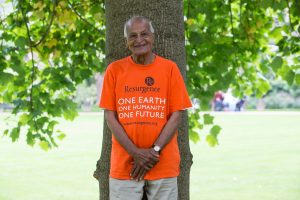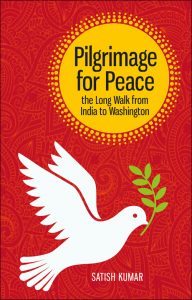Former monk turned environmental activist Satish Kumar – author of Pilgrimage for Peace: the Long Walk from India to Washington, to be published 27 May 2021 – shares his extraordinary story of walking 8,000 miles without spending any money, and eating only vegetarian food, to bring peace to people and planet

Credit: Roy Riley
Beginning at the grave of Mahatma Gandhi and ending at the grave of John F Kennedy at the height of the Cold War in the 1960s, Kumar – then aged 25 – and his friend EP Menon, weathered snow and sandstorms, treacherous mountain passes, hunger, extreme cold, countless psychological and physical hardships, racial aggression and the threat of death by bullets, to deliver their message of peace to the heads of state in the world’s four nuclear power capitals of Moscow, Paris, London and Washington. Satish Kumar speaks to Kindred Spirit about his new book, Pilgrimage for Peace.
Could you tell us about your new book, Pilgrimage for Peace: the Long Walk from India to Washington, and why you decided to write it now?
Originally I had written this book in Hindi, immediately after my long walk from India to Washington. I also wrote a chapter about my walk in my autobiography,
No Destination. This was a brief overview of the walk. A number of people have been asking me over and over to write the full story in English. The
British Film Institute is interested in making a film about the walk. So, I thought that it would be a good idea to write the full story of my walk properly and in greater detail. That is how this book has come about.
In the book, the readers will learn the ups and downs of my 8,000 mile pilgrimage for peace, which I undertook with a friend. It took two and half years and we made this long journey without a penny in our pockets. We depended totally on the generosity of strangers. We went to Pakistan, Afghanistan and Iran, then to Moscow, and from there we walked through Eastern Europe to Western Europe and to London. We sailed across the Atlantic and walked to Washington DC. We had the great pleasure of meeting Martin Luther King. Then we went to Tokyo and walked to Hiroshima, before returning to India. I implore you to read the whole story in the book.
With war constantly in the news today, along with global crises of disease, climate change and inequality, how is the message of this book both timely and vital?
Making peace is a timeless – yet timely – mission. In fact, problems such as climate change are the results of human arrogance. Humanity is at war with nature. The true solution to the environmental crisis is making peace with our precious planet Earth. Poverty and inequality are also the results of lack of peace among humans. We need to realise that we are part of one humanity and we are part of nature. The whole cosmos is our country. The whole Earth is our home, Nature is our family and love is our religion. This is the message of my book. And what could be more timely and vital than making peace within, making peace with people and making peace with the Earth?
Your book shares the legendary and perilous quest of your youth: a two-year walk across the world, risking all to bring peace for people and planet. Could you tell us a little about this journey and what prompted you to set out on such a quest? What was the biggest spiritual lesson you learned during this time?
The prompting came from the imprisonment of Lord Bertrand Russell. When he was protesting against nuclear weapons, he was arrested and put in jail. When I read this news, I said to my friend, “Here is a Nobel Prize winner – Lord Russell – going to jail at the age of 90. What are we, the young men doing? Drinking coffee in a comfortable restaurant! We should do something for world peace”. After a long discussion we came to a decision: that we should walk to the four nuclear capitals of the world.
Our greatest spiritual lesson was very simple. Before we are Christians, or Muslims, or Hindus, we are humans. Before we are Indians, Europeans, Africans or Americans, we are humans. Before we are communists, socialists or capitalists, we are humans. We need to go beyond this identity politics, we need to go beyond these labels and transcend all divisions. Diversity should be celebrated. To make peace in the world, we need to see unity in diversity.
You write about delivering 'packets of humble peace tea' to the White House during your pilgrimage. What prompted you to choose tea as a gesture of peace?
When we were walking in Georgia near the Black Sea we were invited to a tea factory. There, one young woman had an amazing idea. She gave us four packets of tea, and said, “I am an ordinary person working in a tea factory. I can never go to Moscow, Paris, London and Washington. But you are going there. Please be my messenger – deliver a packet of peace tea to the nuclear leaders, and tell them that if ever they get a mad thought of pressing the nuclear button, please just stop for a moment and have a fresh cup of tea. That will give a moment to think that the nuclear weapons will not only kill your opponents, they will kill every man, woman and child, and all animals, forests and insects. So, don’t push the button. Have a cup of peace tea!”
That was a very powerful message. We took it seriously and delivered the packets of humble peace tea to the Kremlin, the Élysée Palace, 10 Downing Street and the White House.
You mention that 'it is the responsibility of every citizen to free themselves from fear, then politicians for peace will emerge'. Can you tell us a little more about what this means, and how we can free ourselves from fear?
Peace is in the hands of the ordinary people. This is why we walked to meet the ordinary people. Because we fear other nations, other religions and other political systems we support the military buildup. To achieve peace we need to drop the fear of the other. The antidote to fear is trust. We need to trust ourselves. We need to trust the world and the universe. We need to trust the people. We need to trust the power of dialogue and diplomacy. There can be no peace without trust. The sun of trust will dispel the darkness of fear.
As a former monk turned peace and environmental activist, and editor emeritus of the UK's longest-standing green magazine, Resurgence & Ecologist, do you believe that peace and the environment are linked? How can we foster and create harmony between our mind, body and spirit, and with each other and mother nature?
Certainly, the peace movement and the environmental movement are two sides of the same coin. We have to have peace of mind and peace in our hearts. Inner peace is a prerequisite for outer peace. Often, wars are about the control of the natural resources. If people and nations can learn to be contented with what they have in their locality and live ecologically sustainable lives, then there will be no need for wars. Therefore, the peace activists and environmental activists need to work together. If we do not make peace with nature, we will not be able to make peace with people. With the same token, if we do not make peace with people we will not be able to make peace with Nature.
Finally, do you have a life motto or words of wisdom that you live by that you would like to share with our online readers?
There is no way to peace: peace is the way. First of all, make peace with yourself and love yourself. Then you will become a fountain of peace. Being peace is the way to making peace. Learning to live peacefully every step and every moment is the key to world peace.
 Find out more:
Find out more:
Satish Kumar is long-time peace and environment activist and former monk who has been quietly setting the global agenda of change for over 50 years. He settled in the United Kingdom after an 8,000-mile peace pilgrimage and became editor of Resurgence magazine, a position he held from 1973-2016. During this time, he founded Devon's Schumacher College, authored several books, and presented the successful documentary Earth Pilgrim. He lives in Devon, UK.
Pilgrimage for Peace: the Long Walk from India to Washington (£9.99) is published by Green Books and is available from www.resurgence.org/shop


 Find out more:
Find out more:

